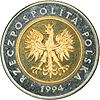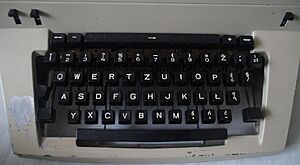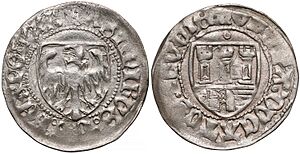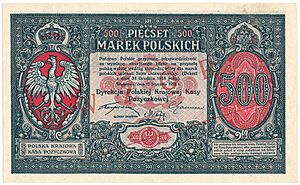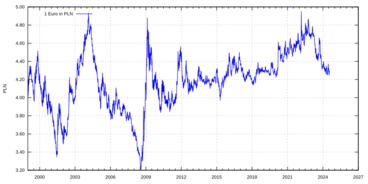Polish złoty facts for kids
Quick facts for kids Polish złoty |
|||||
|---|---|---|---|---|---|
|
|||||
| ISO 4217 Code | PLN | ||||
| User(s) | |||||
| Inflation | 3.9% (YoY, January 2024) | ||||
| Source | Narodowy Bank Polski | ||||
| Method | CPI | ||||
| Subunit | |||||
| 1⁄100 | grosz | ||||
| Symbol | zł | ||||
| grosz | gr | ||||
| Plural | See Name and plural forms | ||||
| Coins | 1 gr, 2 gr, 5 gr, 10 gr, 20 gr, 50 gr, 1 zł, 2 zł, 5 zł | ||||
| Banknotes | |||||
| Freq. used | 10 zł, 20 zł, 50 zł, 100 zł, 200 zł | ||||
| Rarely used | 19 zł, 500 zł | ||||
The Polish złoty (say: zwah-tee) is the official money of Poland. It's used for everything you buy there! One złoty is made up of 100 smaller coins called grosz (say: grosh). The złoty is the most traded money in Central and Eastern Europe. It's also the 21st most traded currency in the world.
The word złoty comes from the Polish word for 'golden'. The grosz part is similar to an old English coin called a 'groat'. The złoty first became Poland's official money on February 28, 1919. It started being used in 1924. Only two places are allowed to make złoty coins and banknotes: Polish Security Printing Works and Mennica Polska, both in Warsaw.
In the early 1990s, prices in Poland went up very quickly. Because of this, the money had to be changed. So, on January 1, 1995, 10,000 old złoty became just one new złoty. Poland is part of the European Union. This means it will eventually use the euro instead of the złoty. But there's no set date for when this will happen.
Contents
What does "złoty" mean?
The word "złoty" is a Polish word that means "golden". So, the name of the money literally means "the golden one". In Polish, the word "złoty" changes depending on how many you are talking about.
- If you have 1 złoty, you say złoty.
- If you have 2, 3, or 4 złoty, you say złote.
- If you have 5 or more złoty, you say złotych.
It's a bit tricky! But don't worry, in English, people usually just say "złoty" for any amount. For example, "2 złoty" or "100 złoty".
The złoty symbol
The official symbol for the złoty is zł. It's made from the first two letters of the word "złoty". The symbol for the smaller grosz coin is gr.
A brief history of the złoty
The first złoty
The very first money used in Poland was called the denar. This was way back in the 900s! These coins were usually made of silver. Back then, people used a unit of weight called a grzywna, which was equal to 240 denars.
Later, in the 1300s, a coin called the Prague groschen became very popular. It was used all over Central Europe. The word "złoty" was first used in the 14th and 15th centuries. It referred to foreign gold coins like ducats. In 1496, Poland's parliament decided to create its own złoty. It was set at a value of 30 grosz for one gold coin. This was the main way the złoty was divided until the 1800s. In 1528, King Sigismund I made the złoty official money.
The Polish money system was quite complicated for a long time. But in the 1700s, King Stanisław II Augustus simplified it. He made the złoty the main unit, divided into 30 groszy.
Big changes happened to the money during the Kościuszko Uprising in 1794. Poland was losing land and money was scarce. So, Tadeusz Kościuszko started printing paper money. These were the first Polish banknotes.
Even after Poland was divided by other countries, the złoty was still used for a while. But eventually, other currencies like the Russian rouble and the German mark took its place. During World War I, the złoty was replaced by the Polish marka. This marka was very unstable and caused a lot of problems for Poland's economy.
The second złoty
The złoty was brought back in April 1924 by the Finance Minister, Władysław Grabski. It replaced the marka at a rate of 1 złoty for every 1,800,000 marks! This new złoty was divided into 100 grosz, not 30.
After it was introduced, the złoty was linked to the United States dollar. This helped to make it more stable. The Polish government decided to use the gold standard. This meant that the value of the złoty was tied to a certain amount of gold. This helped to attract investors from around the world.
During World War II, Germany took over Poland. They set up a new bank in Kraków. Old banknotes were stamped with new marks. The exchange rate was 2 złoty for 1 German Reichsmark.
After the war, the National Bank of Poland was created in 1945. New banknotes were designed.
The third złoty (PLZ)
In 1950, a third version of the złoty was introduced. This time, 100 old złoty became 1 new złoty. The new banknotes were from 1948, and the new coins from 1949. These banknotes went from 10 złoty all the way up to 5 million złoty!
The fourth złoty (PLN)
After communism ended in Poland in 1989, there was a lot of hyperinflation. This means prices went up incredibly fast. So, the złoty had to be changed again. On January 1, 1995, 10,000 old złoty (PLZ) became just one new złoty (PLN).
New coins and banknotes were released. These new notes feature pictures of Polish kings and queens. They were first printed in London and later in Warsaw.
Between 2013 and 2014, the banknotes got new security features. This makes them harder to copy. In 2017, a new 500 złoty banknote was released. It features King John III Sobieski. In 2019, a special 19 złoty note was made. The National Bank of Poland has also announced plans for a 1000 złoty note in the future.
Future of the złoty
When Poland joined the European Union in 2004, it agreed to eventually adopt the euro. But there's no specific date for this. Poland needs to meet certain economic conditions first. Many people in Poland have different opinions about switching to the euro. Recent surveys show that about 60% of people support adopting the euro.
Banknotes of Poland
Polish banknotes have different sizes. They get longer and wider as their value goes up. The front of each banknote shows a Polish king or queen. They are shown in order from the earliest ruler to the latest. The back of the banknotes shows important landmarks or objects from Poland's history.
The notes also have the Polish coat of arms and signatures from the leaders of the National Bank of Poland.
| Image | Value | Dimensions | Main colours | Description | Date of | ||||
|---|---|---|---|---|---|---|---|---|---|
| Obverse | Reverse | Obverse | Reverse | series | circulation | ||||
| 10 złotych | 120 × 60 mm | Brown | Mieszko I | Denarius coin Romanesque columns from the Tyniec Abbey |
1994
2012 |
1 January 1995
7 April 2014 |
|||
| 20 złotych | 126 × 63 mm | Pink, purple | Boleslaus I the Brave | Denarius coin Rotunda of Saint Nicolas and a fragment of Gniezno Doors |
1994
2012 |
1 January 1995
7 April 2014 |
|||
| [[
File:Pope-john-paul-ii 50 zlotych bill..png ]] |
50 złotych | 132 × 66 mm | Blue | Casimir III the Great | Polish white eagle with royal regalia Kraków and Kazimierz by Hartmann Schedel |
1994
2012 |
1 January 1995
7 April 2014 |
||
| 100 złotych | 138 × 69 mm | Green | Władysław II Jagiełło (Jogaila) | Polish white eagle with Grunwald swords and Teutonic armour Malbork Castle |
1994
2012 |
1 January 1995
7 April 2014 |
|||
 |
200 złotych | 144 × 72 mm | Gold, yellow | Sigismund I the Old | Polish white eagle from the Sigismund's Chapel Wawel Castle |
1994
2015 |
1 January 1995
12 February 2016 |
||
| 500 złotych | 150 × 75 mm | Light blue, pink, gold and brown | John III Sobieski | Polish white eagle Wilanów Palace |
2016 | 10 February 2017 | |||
Exchange rates
This table shows how the Polish złoty has exchanged with other major currencies over the years. A higher number means you needed more złoty to buy one unit of that foreign currency.
| Year | USD | EUR | DEM | GBP | CHF | JPY | BTC |
|---|---|---|---|---|---|---|---|
| 1990 | 9500.00 | 12070.50 | 5864.19 | 16862.50 | 6884.05 | 65.45 | |
| 1991 | 10584.26 | 13088.29 | 6378.62 | 18652.81 | 7379.05 | 78.7235 | |
| 1992 | 13630.12 | 17662.35 | 8761.51 | 24009.90 | 9742.76 | 107.7766 | |
| 1993 | 18164.84 | 21204.91 | 10975.20 | 27274.86 | 12308.00 | 164.16 | |
| 1994 | 22726.95 | 26913.49 | 14049.60 | 34772.23 | 16670.93 | 224.16 | |
| Re-denomination (10000:1) | |||||||
| 1995 | 2.4244 | 3.1358 | 1.6928 | 3.8257 | 2.0545 | 0.0258 | |
| 1996 | 2.6965 | 3.3774 | 1.7920 | 4.2154 | 2.1826 | 0.0248 | |
| 1997 | 3.2808 | 3.7055 | 1.8918 | 5.3751 | 2.2627 | 0.0272 | |
| 1998 | 3.4937 | 3.9231 | 1.9888 | 5.7907 | 2.4149 | 0.0268 | |
| 1999 | 3.9675 | 4.2270 | 2.1612 | 6.4197 | 2.6413 | 0.0350 | |
| 2000 | 4.3464 | 4.0110 | 2.0508 | 6.5787 | 2.5747 | 0.0403 | |
| 2001 | 4.0939 | 3.6685 | end 1.9558 | 5.8971 | 2.4298 | 0.0337 | |
| 2002 | 4.0795 | 3.8557 | – | 6.1293 | 2.6288 | 0.0329 | |
| 2003 | 3.8889 | 4.3978 | 6.3570 | 2.8911 | 0.0339 | ||
| 2004 | 3.6540 | 4.5340 | 6.6904 | 2.9370 | 0.0337 | ||
| 2005 | 3.2348 | 4.0254 | 5.8833 | 2.5999 | 0.0294 | ||
| 2006 | 3.1025 | 3.8951 | 5.7116 | 2.4761 | 0.0266 | ||
| 2007 | 2.7667 | 3.7829 | 5.5310 | 2.3035 | 0.0235 | ||
| 2008 | 2.3708 | 3.4908 | 4.2200 | 2.2291 | 0.0234 | ||
| 2009 | 3.1175 | 4.3276 | 4.8563 | 2.8665 | 0.0333 | 0.0000 | |
| 2010 | 3.0179 | 3.9939 | 4.6587 | 2.8983 | 0.0345 | 1.2301 | |
| 2011 | 2.9636 | 4.1190 | 4.7463 | 3.3474 | 0.0373 | 40.049 | |
| 2012 | 3.2581 | 4.1852 | 5.1605 | 3.4724 | 0.0409 | 15.629 | |
| 2013 | 3.1608 | 4.1975 | 4.9437 | 3.4100 | 0.0324 | 607.98 | |
| 2014 | 3.0315 | 4.1631 | 5.0167 | 3.3816 | 0.028778 | 1,598.02 | |
| 2015 | 3.5725 | 4.3078 | 5.5296 | 3.5833 | 0.029671 | 1,535.13 | |
| 2016 | 3.9011 | 4.2615 | 5.7862 | 3.9394 | 0.032411 | 2,217.11 | |
| 2017 | 3.6703 | 4.2412 | 4.7031 | 3.7001 | 0.033012 | 16,173.71 | |
| 2018 | 3.7501 | 4.2618 | 4.8012 | 3.8208 | 0.034231 | 28,413.75 | |
| 2019 | 3.8103 | 4.3021 | 4.8703 | 3.8934 | 0.036213 | 28,175.29 | |
| 2020 | 3.8972 | 4.4445 | 4.9969 | 4.2132 | 0.037254 | 47,550.03 | |
| 2021 | 3.8618 | 4.4659 | 5.3102 | 4.2239 | 0.035338 | 180,883.46 | |
| 2022 | 4.4584 | 4.6845 | 5.4951 | 4.6667 | 0.033428 | 108,311.12 | |
| 2023 | 4.1193 | 4.5168 | 5.1762 | 4.6713 | 0.029087 | 133,669.72 | |
| 2024 | 3.9843 | 4.2923 | 5.0117 | 4.3875 | 0.026262 | 221,573.47 | |
| Current PLN exchange rates | |
|---|---|
| From Google Finance: | AUD CAD CHF EUR GBP HKD JPY USD CZK HUF SEK |
| From Yahoo! Finance: | AUD CAD CHF EUR GBP HKD JPY USD CZK HUF SEK |
| From XE.com: | AUD CAD CHF EUR GBP HKD JPY USD CZK HUF SEK |
| From OANDA: | AUD CAD CHF EUR GBP HKD JPY USD CZK HUF SEK |
| From fxtop.com: | AUD CAD CHF EUR GBP HKD JPY USD CZK HUF SEK |
Images for kids
See also
 In Spanish: Esloti para niños
In Spanish: Esloti para niños
- Commemorative coins of Poland
- Economy of Poland
- Historical coins and banknotes of Poland
- Poland and the euro
- Polish coins and banknotes



